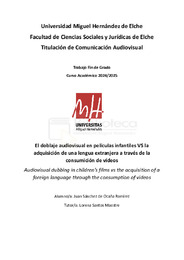Por favor, use este identificador para citar o enlazar este ítem:
https://hdl.handle.net/11000/37277Registro completo de metadatos
| Campo DC | Valor | Lengua/Idioma |
|---|---|---|
| dc.contributor.advisor | Santos Maestre, Lorena | - |
| dc.contributor.author | Sánchez de Ocaña Ramírez, Juan | - |
| dc.contributor.other | Departamentos de la UMH::Ciencias Sociales y Humanas | es_ES |
| dc.date.accessioned | 2025-09-09T10:05:36Z | - |
| dc.date.available | 2025-09-09T10:05:36Z | - |
| dc.date.created | 2025-06 | - |
| dc.identifier.uri | https://hdl.handle.net/11000/37277 | - |
| dc.description.abstract | Las películas animadas son el género más consumido entre los públicos infantiles por su facilidad de comprensión y su trama fantástica y atractiva visualmente. Gracias a estas, tanto la herramienta que es la animación para contar historias, como la instrucción pedagógica, se han realzado enormemente, dado que la implementación del medio audiovisual en las clases de Educación Primaria resulta pertinente, y compone un elemento dinamizador de las nociones del aula. Por ello, y dado su carácter visual, la influencia de esta subcategoría de filmes en las clases de idiomas, y especialmente en la de inglés, resulta sencillo de explorar. Debido a estos motivos, este Trabajo de Fin de Grado investiga acerca de varios fenómenos, como la influencia de las mayoras productoras de animación en la industria cinematográfica actual; la percepción del público infantil respecto a las barreras idiomáticas o sensoriales de la animación; o la delimitación de públicos objetivos para determinados filmes. El objetivo es demostrar la necesaria coexistencia entre las versiones dobladas y originales para el correcto entendimiento del arte. El análisis de la investigación se ha llevado a cabo a través de una revisión bibliográfica y de un análisis cuantitativo basado en un cuestionario realizado a dos centros escolares. El cuestionario, relacionado con diversas actividades de experimentación o debate sobre el doblaje como disciplina y como vertiente artística audiovisual, se basa en siete películas de la compañía Pixar, estrenadas en la década del 2000. A grandes rasgos, los datos obtenidos indican una clara motivación por parte del alumnado por involucrar al medio animado y audiovisual en sus lecciones, y una influencia del entorno hacia los mismos alumnos para aprender idiomas en contextos sociales o de ocio para así evolucionar sus habilidades comunicativas. Sin embargo, también se muestra una necesidad de comprensión y afinidad lingüística que solo el doblaje a determinados dialectos puede proveer. | es_ES |
| dc.description.abstract | Animated films are the most consumed genre among young audiences due to their ease of comprehension and their visually appealing and whimsical plots. Thanks to them, both animation as a storytelling tool and as a pedagogical resource have been greatly enhanced, given that the implementation of audiovisual media in Primary Education is highly relevant and serves as a dynamic element in classroom learning. For this reason, and due to its visual nature, the influence of this subcategory of films in language lessons—particularly English—is easy to explore. Based on these premises, this Final Degree Project investigates several phenomena, such as the influence of major animation studios on the current film industry; children's perception of linguistic or sensory barriers in animation; and the identification of target audiences for specific films. The aim is to demonstrate the necessary coexistence between dubbed and original versions to ensure a proper understanding of the art form. The analysis was carried out through a literature review and a quantitative study based on a questionnaire conducted at two primary schools. The questionnaire, related to various experimental or discussion-based activities on dubbing as both a discipline and an audiovisual artistic branch, focuses on seven Pixar films released in the 2000s. Broadly speaking, the data collected indicate a clear motivation among students to involve animated and audiovisual media in their lessons, as well as an influence from their environment encouraging them to learn languages in social or leisure contexts in order to develop their communication skills. However, the results also reveal a need for linguistic comprehension and affinity that only dubbing into certain dialects can provide. | es_ES |
| dc.format | application/pdf | es_ES |
| dc.format.extent | 57 | es_ES |
| dc.language.iso | spa | es_ES |
| dc.publisher | Universidad Miguel Hernández de Elche | es_ES |
| dc.rights | info:eu-repo/semantics/openAccess | es_ES |
| dc.rights | Attribution-NonCommercial-NoDerivatives 4.0 Internacional | * |
| dc.rights.uri | http://creativecommons.org/licenses/by-nc-nd/4.0/ | * |
| dc.subject | doblaje | es_ES |
| dc.subject | animación | es_ES |
| dc.subject | idiomas | es_ES |
| dc.subject | Educación Primaria | es_ES |
| dc.subject | Pixar | es_ES |
| dc.subject | dubbing | es_ES |
| dc.subject | animation | es_ES |
| dc.subject | languages | es_ES |
| dc.subject | Primary Education | es_ES |
| dc.subject.other | CDU::3 - Ciencias sociales::316 - Sociología. Comunicación | es_ES |
| dc.title | El doblaje audiovisual en películas infantiles VS la adquisición de una lengua extranjera a través de la consumición de vídeos | es_ES |
| dc.title.alternative | Audiovisual dubbing in children’s films vs the acquisition of a foreign language through the consumption of videos | es_ES |
| dc.type | info:eu-repo/semantics/bachelorThesis | es_ES |

Ver/Abrir:
TFG_CAU-Sánchez de Ocaña Ramírez, Juan.pdf
2,73 MB
Adobe PDF
Compartir:
 La licencia se describe como: Atribución-NonComercial-NoDerivada 4.0 Internacional.
La licencia se describe como: Atribución-NonComercial-NoDerivada 4.0 Internacional.
.png)